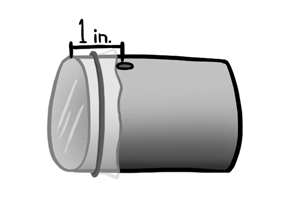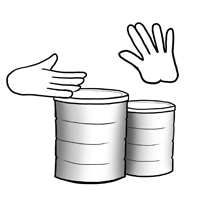Education Uprising: Culture Shift
- 5 DIY Musical Instruments You Can Make From Stuff Around the House
- Share

Photo courtesy of The University of Iowa Libraries / Flickr.
5 DIY Musical Instruments You Can Make From Stuff Around the House
Craft instruments from easy-to-find materials and invite more music into your family's life.
Craft your own instruments from easy-to-find materials for the next creative protest or family sing-along. Assemble the band and be heard.

1. Comment with a kazoo
The kazoo is easily portable, inexpensive, and inherently amusing. A chorus of kazoos is disarming but loud enough to get your message across. Start with any short tube, like a toilet paper roll. Use a hole punch to make a hole a little less than an inch from one end. Place a piece of wax paper over the end closest to the punched hole and slide a rubber band over the end to keep the paper in place. Hold the open end of the tube up to your mouth and hum.
2. Shake it
The tambourine has turned up everywhere from the temples of ancient Egypt to the gatherings of Occupy. This scrapyard version made of wire and bottle caps is the most basic form of tambourine. Punch holes in the centers of 15-25 bottle caps using a nail, hammer, and block of wood for support. Feed a sturdy, two-foot-long wire through the holes and bend the ends back to form a loop. Wrap duct tape around the overlap to cover the sharp ends. Play your tambourine, man.

3. Lift up your voice
It’s amazing what you can do with the human voice. Gather friends or arrange a flash mob chorus to bring unexpected song to a public space. Choose a tune and lyrics simple enough to accommodate harmony and dissonance from the varied vocalists of your group. Keep time, breathe deeply, and sing from your soul.
4. Get rhythm
The Afro-Cuban bongos consist of two drums held between the knees. Play by striking the skin of the drum near the rim with fingers and palms. Don’t use your knuckles.

A simple version of the bongos can be made with two empty containers—oatmeal boxes or coffee cans work well. To get the difference in pitch, you can shorten one container by a few inches, or find containers of different sizes. You may get greater resonance by removing one end of the container. The plastic lid of some containers is suitable for drumming. If not, use a deflated balloon for the “skin” of your drums. Cut the stem of the balloon, stretch it across the container top, and secure with a rubber band. Tie your drums together with twine or rope.
5. Toot on a root
The snake charmer’s flute was used in protests that blew the whistle on government apathy and corruption during 2013 protests in the Gaya district of Bihar, India.

You don’t need wood to make a simple woodwind. Uproot the largest carrot from your vegetable garden and clean thoroughly. Cut an inch off the top and bottom of the carrot, setting the pieces aside for later use. Then hollow out the carrot using a manual drill or an electric drill on slow speed. Hollow out more space at the wider, top end of the carrot. Use one of the trimmed pieces of carrot, or a piece from another carrot, to make a plug for the wider end. Once fitted, remove the plug, cut one side flat and replace, creating an opening to blow into. About an inch from the widest end, make a quarter-inch slit across the width of the carrot. A little less than another inch down the shaft, use a small chisel to cut out a wedge toward the slit to create an opening. Drill two or three small holes into the rest of the shaft for differing notes.
Hold the carrot recorder firmly against your lips and blow directly into the mouthpiece. Some adjustment of the positioning of the plug and the size of the wedged-shaped opening may be necessary to get a tone. You can find videos on YouTube that demonstrate the fine art of crafting a carrot recorder, and how to make flutes from plants, paper or PVC.


